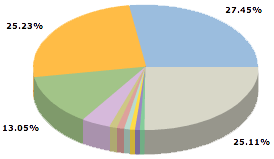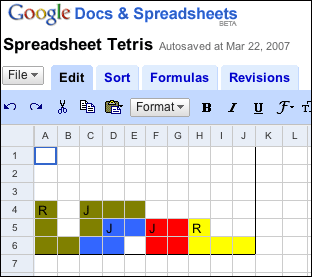Editorial
The good folks at Coudal Partners have asked me to guest edit their wonderful, ceaseless flow of linkage known as Fresh Signals (feed) for the month of September. I’m jt.
Apparently I didn’t scare Coudal too badly at dinner last week. Or perhaps that secured the job for me?
This should be fun.
Update: I probably should take this opportunity to remind readers that I have my own fresh signals (lowercase), called Marginalia, which is a list of interesting stuff found around the web. It’s in the right column on the web or you can subscribe to it separately or as a feed blended with the posts.
Data in the cloud
In response to my weak rationalization about why I am getting an iPhone Ian asked about which web apps I use. So here they are (with the offline apps they synch with on both Mac and PC).
| function | web app | offline Mac app | offline PC app |
| Gmail | Thunderbird | Thunderbird | |
| calendar | Google Calendar | iCal* | Sunbird** |
| contacts | Plaxo | OSX Address Book | Thunderbird |
| lists/notes | Backpack | Packrat | [none] |
| project collaboration | Basecamp | [none] | [none] |
| RSS | Newsgator | NetNewsWire | FeedDemon |
| blog authoring | Movable Type | Ecto | Ecto |
[*] Does not support two-way synching.
[**] The latest build of Sunbird (0.5) does support two-way synching. If I have to do that (like on an airplane) I use Sunbird on the Mac.
Of course this says nothing of all the other data that lives out in the tuboverse. Flickr, Ancestry.com, Google Spreadsheets and on and on. But these have no desktop equivalents at all so I don’t include them here. Suffice to say, most of my most critical data lives somewhere online.
iPhone, I am ready for you if you will have me.
(HTML tables! Yay, old school layout!)
Socio
Been thinking a lot about social networks lately. This is mostly because I am part of a team building one. But is just as likely due to Facebook’s amazing proliferation lately.
Figured I’d collect all my nets in one place. Because, you know, I need more friends. (* means you gotta be a part of the network to see the profile.)
Cork’d
del.icio.us
Dopplr* (Closed beta, unfortunately. I have a few invites left if you are interested.)
Facebook*
Flickr
Last.fm
Library Thing
LinkedIn
Twitter (And my car’s Twitter page.)
And let us not forget Isolatr, the anti-social network. Helping you find where other people aren’t.
Rock your tonsil rock
I’ve been interested in what makes a vibrant online community lately. How to begin one? How to sustain one? How not to let it spiral out of control? Ascent Stage is not in any sense a community. Traffic is too low, posts too infrequent.
But recently an old post came back to life and has me wondering. In June 2005 I wrote about a disgusting biological phenomenon known as tonsiloliths. I wrote it after one of my co-workers plucked one from her mouth. Being a fan of all things disgusting I had to write about it. Turns out lots of people suffer from these nasties. My post was not a first-hand account of a sufferer or a source of any medical advice. In fact, I was pretty crude about the whole thing. But, it attracted relieved commenters early on who were simply glad to find others like them.
Recently the post has reached a bit of a tipping point. Comments are way up; most are relatively long, breathless expressions of gratitude to be part of a small group of people helping each other. I read along as a third-party, an accidental self-help guru.
Over a quarter of all site traffic (27.45%) to Ascent Stage goes to this post alone.

(Rounding out the other big slices of the pie in order are How to create a LEGO mosaic, everything else, and the home page.)
So what’s the lesson for online communities here? Well, probably that there’s a lot of luck in fomenting one. The web is the perfect medium for yoking together micro-communities. You’d think that all you have to do is write about a topic that’s not been covered elsewhere (especially if it is medical in nature) and you’ll probably have a little tribe on your hands. But really, it can be just dumb luck.
Kinda warms the heart, though.
The joy of spreadsheets
I’m really liking Google Spreadsheets.
Fact is, I’ve never had much use for spreadsheets, which is why I’m hopelessly lost in pivot tables and anything more complex than a sum formula. (My wife, by way of contrast, can make a spreadsheet compile to solve prove Fermat’s Theorem, I am quite sure.) Still, I have always loved spreadsheets’ boxy structure. I keep lots of data in spreadsheets, but it doesn’t do anything. Just sits there. Tabularly.
But a shared online spreadsheet is a different beast altogether. I have a variety of home-related data in gSpread (sounds dirty, no?) so my wife and I can reference the same stuff. Two co-workers of mine and I keep track of daily You Don’t Know Jack scores in a shared sheet. (By year’s end — assuming Google adds charts to the tool — the YDKJ score log should be an interesting set of data to mine.)
This weekend my college pals and I conducted our annual fantasy baseball draft. It is an excuse to get together in person for much hazing and idiocy, but this year gSpread made it much more efficient. Most of us had laptops open with a Excel sheet imported into Google. One person updated the main player list, another the By Pick list, and another the By Team list. We all saw everything instantly, editing the same tables simultaneously. As did a friend at home who could not make it to Chicago. A perfect use for shared data.

But the best use by far is what I call two-player, slow-motion Tetris. Actually it is a kind of a merger of Tetris and checkers or Connect Four. Each player (or collaborator in gSpread parlance) clicks on cell that randomly selects a piece (=randbetween(1,7)) then places that piece in whatever rotation desired. The goal is to clear a line as in normal Tetris but also to block someone else from doing so. Letters in the pieces let players know which pieces are theirs — useful since the game takes weeks to play out. Fun, but dorky. No, fun because dorky. Who’s in?
Dialogical
In watching Attack of the Clones again (painful indeed, but my boy asked) I noticed a strange line of dialogue. Obi-Wan at the clone factory is trying to establish a connection back to his peeps at Jedi HQ. He asks his droid to send the message “care of the old folks home.” Seemed odd, so I Googled it. Passionate discussions like this, friends, are why I love the Intertubes so.
Speaking of shows my kids watch, I’m still enamored with the Challenge of the Superfriends on DVD. Here’s one reason why. The word “doom.” It is said often and always with subwoofer insidiousness. Doom! (Actually anything the narrator says is pretty cool. I’ve had the line “Deep within the gaseous core of Saturn …” in my head all day.)
Museum-as-website
Paul Bausch makes some good points on why museums should be more like today’s web. What’s interesting is that the spark for the post came from an expectional interaction with a human tour guide.
The tour included a stop at a recreation of an 1800’s store run by Chinese immigrants. As you step inside you see lots of stuff that would have been for sale at a store like this, Chinese newspapers and inventory lists from the period, and an audio track playing with people speaking Chinese. Someone in the group asked what the people were saying on the audio track, and the tour guide launched into a story. It turns out he’d had several Chinese speakers on previous tours, and he’d started to piece together what the audio was. Apparently, the museum curators had recorded a mahjong game in progress, and audio in the store was simply some people sitting around playing a game and having a conversation. Most museum-goers in Bend, Oregon would never know what exactly the conversation was about, so it didn’t matter that the audio didn’t faithfully recreate an 1800’s Chinese store.
I was struck by this little exchange, because the tour guide had gone from adding a layer about the exhibit to a little behind-the-scenes information about the construction of the exhibit. And the information hadn’t come from the museum curators, it had come from fellow museum-goers.
Along the way, I noticed other types of information the guide was relating such as trends. He’d say, “everyone always asks about this piece of equipment right here.” And then he’d explain what that was. He was using audience patterns to tune his presentation.
Bausch isolates the characteristics of a great interaction with a knowledgeable human guide and expresses them in terms that sound like what the web does very well: deep info, layered perspective, visitor trend analysis. Many museums have tried to make their physical experiences more interactive, of course (see here, here, here and oh yeah here), but the holy grail of a physical space as malleable and two-way as the web has not been achieved. My team refers to such as a space as a “flexhibit,” but it is more concept at this point than reality.
It is curious that Bausch suggests we use technology to do what the best human guides already do. I can hear a museum director arguing the reverse: that what we really need are more human guides that synthesize info and have a depth of knowledge that equals the best websites. That’s a solution that doesn’t necessarily scale, but then scalability has been the biggest obstacle to making museum exhibits technologically interactive. (Gotta wait in line to punch that button for more info on the wall.)
It’s a tough problem actually and it is complicated by the fact that many museums (like traditional encyclopedias) operate as keepers of culture rather than sharers of it. People can write really informed articles for Wikipedia, but replicating the experience of a museum collection without access to the original material history at your disposal is tricky indeed. Yet we have to try. It isn’t really a cabinet of curiosities if you can’t open the cabinet door or doesn’t make you curious, is it?
I don’t think the solution is standalone kiosks or “information hubs” per se, though they may be part of the solution. The most interactive museum spaces will in fact mimic the best websites as mixtures of superb technology and human community — and that community should necessarily include human guides and docents such as Bausch encountered. What we want is technology that facilitates interaction with humans and with the knowledge embedded in the material history contained in the museum.
Fave
You probably didn’t notice that I removed my blogroll recently. That’s not becuase I’m no longer reading other sites, but rather because I follow so many sites and my interest shifts so often that it seemed silly to call out a subset for special note.
But there’s one site that rises above the rest. Maciej Cegłowski’s Idle Words is this site. Ceglowski is a polymath polyglot and one hell of a writer. He seems partially powered by wanderlust, a tendency that gives his posts a rewarding freshness. Here are some excerpts.
Mooncakes, of course, are the exact cultural analogue of the American Christmas fruitcake, that venerable Christmas pastry of astonishing density that brings people together by uniting the giver and receiver in a shared reluctance to eat it. The Chinese have not yet advanced as far as those intrepid Americans who store a received fruitcake for a year before re-gifting it to another victim, but there are promising signs that the failure to let mooncakes overwinter may just be a function of limited apartment storage space, solvable by applying economies of scale.
On flying from North America to Asia:
If you are a package of avionics software, the North Pole is a stressful place. Depending on how close by you pass, longitude and bearing can change extremely quickly (or converge into an unlucky singularity) and most autopilots throw up their hands and enforce a special wings-level lockout flight mode within a few miles of the pole, to keep from spiraling around it like a housefly circling a light bulb.
NASA dismisses such helpful suggetions as unworthy of its mission of ‘exploration’, likening critics of manned space flight to those Europeans in the 1500’s who would have cancelled the great voyages of discovery rather than face the loss of one more ship.
Of course, the great explorers of the 1500’s did not sail endlessly back and forth a hundred miles off the coast of Portugal, nor did they construct a massive artificial island they could repair to if their boat sprang a leak. And we must remember that space is called space for a reason – there is nothing in it, at least not where the Shuttle goes, save for a few fast-moving pieces of junk from the last few times we went up there, forty years ago. The interesting bits in space are all much further away, and we have not paid them a visit since 1972.
Mile 19
We’re at 115th street, and the crowd has thinned considerably. My legs are much more tired than I expected, and getting stiff – I stop at a water stand, and walk a block before running again. The next five miles will be walk-and-run, trying not to let my legs seize up like they crave to do. A man with a big synthesizer is playing some easy listening jazz number. I resist the urge to trample him (must conserve energy). Who the f*** plays elevator music to motivate tired runners?
Do yourself a favor and visit the site. Ceglowski is proof that blogging doesn’t have to be quick and daily to be satisfying.
Tracking
Today I pulled a $1 bill out of my wallet and saw that it had been stamped with the Where’s George URL. I had read about the dollar bill tracking site before, but this was my first encounter with a tracked bill. So I popped in the serial number and I learned that the bill had previously been in Carmel, Indiana.

Kinda cool, but the real experience was digging into the Where’s George site. It is a huge community of mindbogglingly dedicated bill-trackers. The site has merchandise for sale, forums by region, external fan sites, scoring competitions — things you’d associate with a popular band or videogame, not a site dedicated to tracking denominations of US currency.
But that’s the thing. The map of a bill’s travels around the world isn’t so much the story of the $1 note as it is a visualization of straight-line vectors between fellow dorks. The money is secondary, really. Think of an indiviual bill as little more than a slow-motion chain letter between likeminded, trainspotting money geeks. Once the bill arrives it is plotted on the map and the community grows by one. Where’s George doesn’t track money; it uncovers people who care about tracking money.
Which reminds me of the wine bottle re-gifting from last year. You may recall this as the experiment to see how many times a bottle could be re-gifted. It started in Chicago, jumped once in Chicago, then made its way to Miami where I have lost track of it.* Like Where’s George this small network isn’t so much about where the bottle is as a map of people crass enough to re-gift proudly.
And that’s what’s cool about a social networks. Often the stated reason for the networking (professional connections, hobby information, etc) becomes secondary to the social insight that comes of it. The link makes the node. Not the other way around.
[*] Maybe this Christmas I’ll start a site called Re-Gift Tracker (no, better: Re-Giftr). You’ll be able to enter UPC codes for obviously regifted items and see where they came from. And then there’ll be an interface to Cork’d. And then Amazon. And, and … oh my, Web 2.0 fame and fortune here I come.
Online calendars get serious

Last year I went through Outlook detox and successfully created cross-platform, web-synched versions of my mail and contacts. The calendar part was tougher, since there was no really good online app for the task. In the last couple of months this has changed. Kiko retooled, 30 Boxes launched, and Google Calendar cannonballed right into the pool.
I’ve spent some time really working with 30 Boxes and Google Calendar (Kiko, not so much). Google is the one to bet on, I think, because of their momentum in the space and track record. Also, as Web 2.0ish as 30 Boxes is I’ve come to agree with others that a duration view of events by day and week is crucial (and kinda pretty too) in that you can squint your eyes, find some white space, and simply know that you’re open during that period. The views on 30 Boxes are all list-based and make this kind of spatial reading of your calendar impossible. 30 Boxes does have the edge on integration of non-calendar data, though. You can pop in online web calendars, of course, but you can also read in any RSS feed imaginable. This is very useful for blog posts, weather, and anything else that makes sense to see in a calendar layout. Right now Google only does webcal, no RSS. (Anyone know of an online converter of an RSS feed to webcal?) Integrating specialized calendar feeds (such as those from Basecamp) is especially nice.
30 Boxes also has taken the tagging angle which allows you to filter and syndicate just about any slice of your calendar. Google only allows syndication of whole calendars. They’ll need finer granularity eventually. Google does repeating events and specifically modifications to repeating events much better than 30 Boxes. This becomes a huge deal when you want to skip or modify a particular instance of a repeating event. Obviously Google is well-integrated with GMail.
The glaring omission from all online calendars — and the reason they are not yet on par with mail and contacts — is synching. I can view my calendars in desktop apps (iCal and Sunbird) but I cannot modify them there for synching back to the server. You have to imagine that they are working on this, but from what I read the CalDAV spec is anything but ready for primetime. Also, the PC desktop apps that read iCal are godawful right now. That’s not Google’s or 30 Boxes problem, but it is a hindrance. MozCalendar/Sunbird is way behind Thunderbird and Firefox for sure.
Happy calendaring!














